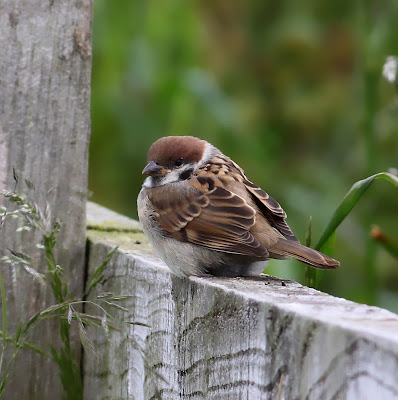Destination Conder Green again this morning. Just a couple of hours later there was a decent list of birds in my notebook plus new pictures to share with blog followers. And remember to "click the pics" for the birding tour.
There must have been a recent hatch or awakening of insects at the line of hawthorns because lots of hirundines and Swifts fed there, all dashing alongside, through and above the hedge. In all I estimated 25+ Swift, 20+ Sand Martin, 14 House Martin and 10 Swallows taking part in the feeding frenzy for an hour or more before most moved on to the next feast.
It was less frenetic on the pool and the river where apart from the noisy Oystercatchers, the wildfowl go about their business in a quiet sort of way. Similar numbers to recent days with 16 Tufted Duck, 1 Teal, 3 Wigeon and then 2 Canada Goose with 2 youngsters. There are 3 broods of Mallards numbering about 15 chicks + 3 adult females, the males seeming to be absent on this Father's Day.
Eurasian Wigeon
Mallard
Waders as normal with 1 Curlew, 15 Redshank and 10 Oystercatcher but a few passerines in evidence with 2 Pied Wagtail, 3 Whitethroat, 5 Greenfinch, 2 Linnet, 5 Tree Sparrow, 6 Goldfinch and then 1 Lesser Whitethroat singing from the car park area.
Tree Sparrow
Two Ravens flew over honking loudly and heading in the direction of Cockersands/Pilling. My cue to take a look at Glasson Dock where I didn't find much save for more Tufted Duck in the dock, Swallows nesting in the toilet block, a Blackbird feeding young and a Grey Heron looking for a fishy breakfast down in the muddy waters of the dock.
Grey Heron
Grey Heron
Blackbird
Mostly From Wiki.
The settlement of Glasson village built up slowly in the 19th century with the main buildings being Christ Church in 1830, a shipyard and Customs House constructed in 1834, a Watch House in 1836, and a Dry Dock in 1841. The shipyards were largely concerned with ship repair rather than shipbuilding, eventually closing in 1968, with the dry dock filled in a year later.
Glasson Dock
The quay was connected to the UK railway network in 1883, operating until the closure of passenger services on 5th July 1930. Goods traffic continued until 7 September 1964. The trackbed of the disused branch-line is now a linear park and cycleway (popular with birders).
A limited amount of commercial traffic still uses the dock, with outbound shipments including coal for the Isle of Man and the Western Islands of Scotland, and incoming cargoes including animal foodstuffs and fertilizer, which are stored in sheds located on the dock side.
River Lune - Glasson looking to Conder Green
The River Conder meets the River Lune at Conder Green, the latter a tiny settlement of a few dozen homes (and The Stork pub) formerly served by the London and North Western Railway's Glasson Dock railway line which had three stations in the parish: one at Conder Green, the terminus at Glasson Dock and a private stop at the local gentry's home of Ashton Hall further north towards Lancaster.
Conder Green
Join Another Bird Blog soon for more news, views, pics and vital information.
This post is linking to Stewart's gallery in Australia .























































.jpg)












